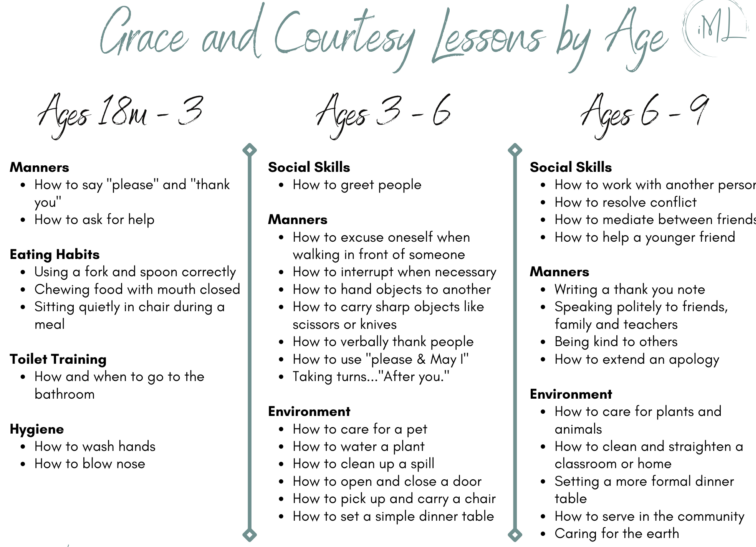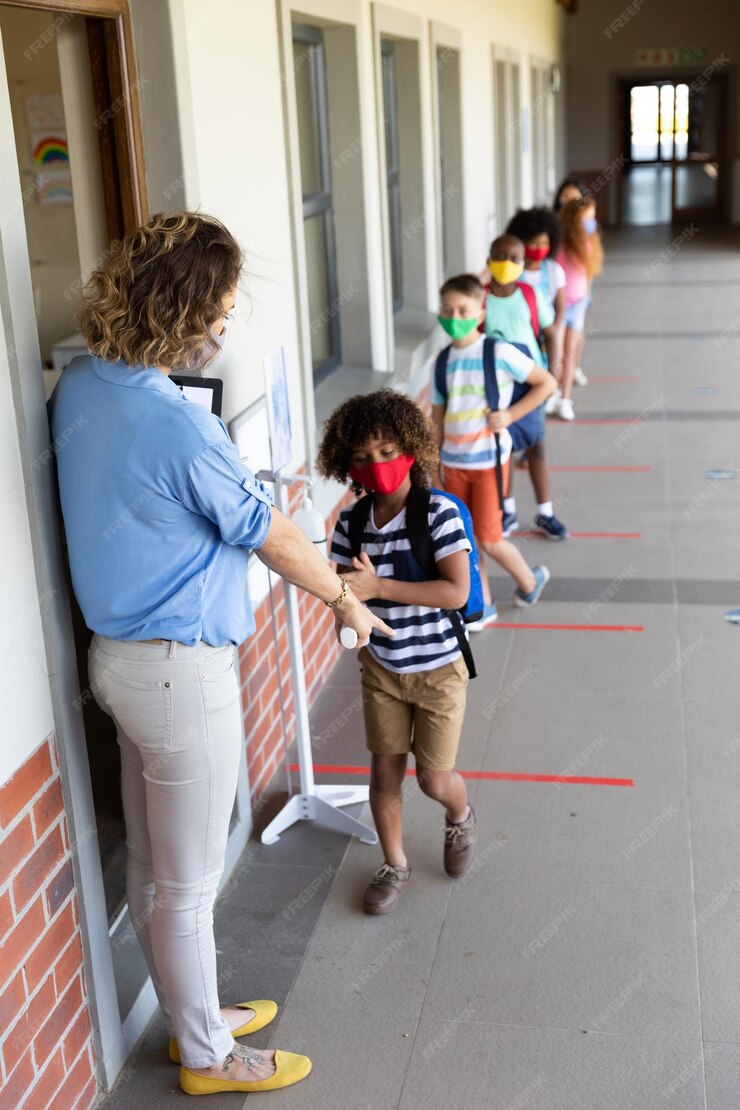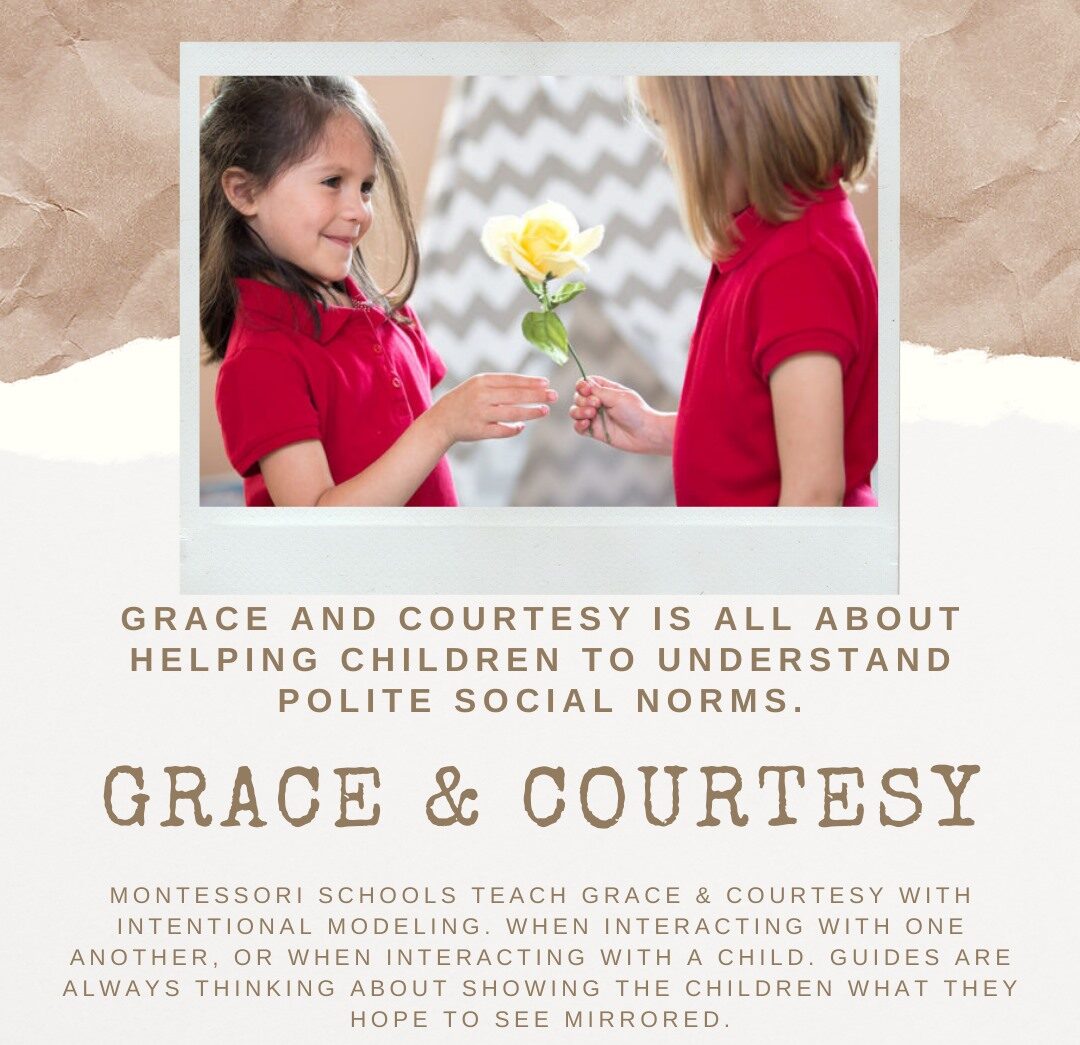Grace and Courtesy Lessons in Montessori training are an fundamental thing of the curriculum, that specialize in instilling values of recognize, kindness, and social competencies in kids. Developed by using Dr. Maria Montessori, these training move beyond mere manners, aiming to cultivate a deeper understanding of social interaction and empathy. Through sensible sports and function modeling, students discover ways to navigate social situations gracefully, communicate successfully, and collaborate harmoniously with their friends. These training no longer best make a contribution to a tremendous lecture room environment however additionally lay the inspiration for lifelong social and emotional competence.
Grace and Courtesy Lessons in Montessori

Example 1:WALKING ON A LINE
MATERIAL
A line on the floor in a room or outside permanently, a piano or a tape recorder with slow harmonious rhythm, flags, glasses with colored water, bells, books and candles.
Introduction
Grace and Courtesy Lessons in Montessori Dr. Montessori was a careful observer, and she noticed that children liked to walk on narrow walls or feces, or even railroad tracks. They enjoyed walking along a limited line and perfecting their sense of balance. The young child is in a sensitive period for the perfection of movement and teachers must be aware of this.
Grace and Courtesy Lessons in Montessori In the classroom we provide for this need with the exercise of “Walking on the Line.” We use a line drawn or painted or taped on the floor in the form of an ellipse, and we teach the children to walk on it.
This is group exercise with two distinct levels:
- Exercises on the line with objects
- Moving to the rhythm of the music
The purpose of these exercises is to aid the children in establishing perfect equilibrium and to help coordinate movements and the development of attention and will.
Here the whole body is involved. These exercises are many and varied and are entrusted to the good sense and discretion of the teacher, as always, for their presentation.
Level 1 : Exercises on the line with objects
In order to help the children refine posture and reinforce holding their heads high, a variety of objects is gathered for the children to carry ( one at a time) while walking on the line. The objects, which vary from time 0 time, may include:
- A stand with flags of all nations
- A tray containing four spoons with a small ball-like object in each one
- A box with small bells tied to long ribbons
- A tray with several candles with paper shields
- A cloth twisted into a circle to form the base for carrying a basket of fruit on the head
- The pink Tower
Presentation
Grace and Courtesy Lessons in Montessori The children begin by standing on the line at spaced intervals. They begin to walk slowly, placing the whole foot on the line, and taking natural steps. Gradually the children shorten their steps, until finally they walk touching the heel of the foot with the toe of the other. The foot should be always directly on the line, the back straight and the head held high. There should be much practice of this.
Additional activities in Grace and Courtesy Lessons in Montessori
- The teacher will place the holder of flags in the center of the ellipse. As the children walk by, they each select a flag . They hold the flag in front of them at arm’s length so that it does not wave, and continue to walk on the line. This may be accompanied by soft music.
- The teacher places the spoons with small “ball-like” objects (possibly large marbles, small rubber balls, ping pong balls) in the center. The child holds the spoon in one hand and tries to keep the hand steady and in equilibrium.
- The teacher places the tray of glasses in the center. The children each pick up a glass by its stem, holding it with the first three fingers of the right hand. They carry the glass in front of them as they walk on the line. The object is to walk with the head held high, placing the feet exactly on the line, without spilling a drop of water.
- The teacher places the basket of bells in the center. Each child must pick up a bell and hold it at arm’s length, by the end of the ribbon. As the children walk along the line they try not to ring the bells.
- The children can try carrying the basket of fruit on their head as they walk on the line, using the twisted cloth as a base. The head should be held high and the feet placed carefully on the line.
- As a special challenge for a child who has mastered all of the above activities, invite the child to try to carry the constructed Pink Tower without dropping any of the cubes. At first the child may start with just the top part of the tower. The teacher can encourage the child to challenge part of the tower. The teacher can encourage the child to challenge himself to add more cubes until he can carry the whole Pink Tower. Pink Tower is a precious material which can be damaged by dropping, and it is therefore carried with great care, and is treasured by the children.
- This work should be repeated daily with the children. This is the first level of this activity.
Level 2 : Moving to the rhythm of music
Grace and Courtesy Lessons in Montessori The second level of activity includes moving to a musical beat. Dr. Montessori uses music to further inspire children as they perfect their movements along the line. Music motivates the children to make an even greater effort to develop their balance and coordination.
It is wonderful to have a musical instrument in the classroom that the teacher can play to accompany the children as they walk on the line. However, a tape recorder or CD player can also be used. At first music can be used to accompany spontaneous movements : walking, running, galloping and skipping. With practice, children will learn to change their movement to match the change in the music.
Marches by John Philip Souza, Schumann’s March, The March from Bizet’s Carmen, When Johnny Comes Marching Home by Gilmore , others are excellent accompaniments to walking. Since young children make quick, small steps. The tempo for marches are faster for small children than for older ones.
Many folk tunes from Russia, Germany, Lithuania, Poland and Scandinavia are wonderful to accompany the faster tempo of running.
Gallops can be accompanied by Weber’s, Pilacca Brillante op 72, Verdi’s Masked Ball, spring Air by Josef Strauss, Beethoven’s Fidelio Sonatina Op. 100 by Dvorak, as well as folk dance from Venezuela, Scotland, Ireland, and Greece.
Skipping can be accompanied by folk tunes from Switzerland, Holland, England, Germany, Ireland, Scandinavia, and America, as well as Strauss’s Die Fledermaus and The English Wassail Song.
The teacher should gather a collection of music to be used as accompaniments when children are walking on the line. The children naturally move in rhythm to the music, and at first no instruction is given. Children will need instruction for learning step patterns used in folk dancing; waltzes and polkas are greatly enjoyed by the children. These steps may be practiced on the line, but not confined to it.
AGE GROUP : ⅖ to ⅗ years
